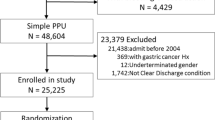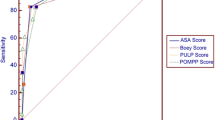Abstract
Introduction
Jabalpur Prognostic Scoring System (JPSS), a simple scoring system, was developed to prognosticate the outcome for perforated peptic ulcer (PPU) in 2003 when there was no dedicated Surgical Intensive Care Unit (SICU) in the authors’ institution. It is based on six easily available parameters, namely patient’s age, perforation-operation interval, mean systolic blood pressure, heart rate, serum creatinine and the presence of comorbid illness. Its accuracy has since been validated by many authors and has been found to be comparable with other prognostic scoring systems. Availability of SICU in the last one decade has prompted us to re-assess the utility and validity of the JPSS in the current age.
Methods
Prospectively collected JPSS data of 214 consecutive patients (prospective group, PG), who underwent Graham’s patch omentopexy closure of a PPU, was compared with the JPSS cohort of 2003 (original group, OG). Sensitivity and specificity were calculated, and accuracy was measured using receiver operating characteristic curve analysis.
Results
The PG had 214 patients, while the OG had 140 patients. PG had significantly more women patients, and a shorter hospital stay, otherwise, both groups were comparable. Postoperative mortality and morbidity, both overall and in different JPSS classes were statistically similar. Overall accuracy of JPSS in PG was 77% with a cutoff of 11 as compared to the OG where these values were 92% and 9 respectively.
Conclusion
JPSS continues to be effective and accurate in predicting the outcome of patients with PPU in the current age.


Similar content being viewed by others
References
Sharma D (2002) Scoring systems for intra-abdominal sepsis: the science of predicting risks. Indian J Surg 64(2):125–147
Nag DS (2015) Assessing the risk: scoring systems for outcome prediction in emergency laparotomies. Biomedicine (Taipei) 5(4):20. https://doi.org/10.7603/s40681-015-0020-y
Jhobta RS, Attri AK, Kaushik R, Sharma R, Jhobta A (2006) Spectrum of perforation peritonitis in India--review of 504 consecutive cases. World J Emerg Surg 5(1):26. https://doi.org/10.1186/1749-7922-1-26
Bali RS, Verma S, Agarwal PN, Singh R, Talwar N (2014) Perforation peritonitis and the developing world. ISRN Surg 2(2014):105492. https://doi.org/10.1155/2014/105492
Hameed T, Kumar A, Sahni S, Bhatia R, Vidhyarthy AK (2020) Emerging spectrum of perforation peritonitis in developing world. Front Surg 15(7):50. https://doi.org/10.3389/fsurg.2020.00050
Bohnen JM, Mustard RA, Oxholm SE, Schouten BD (1988) APACHE II score and abdominal sepsis. Prospective Study. Arch Surg. 123(2):225–229. https://doi.org/10.1001/archsurg.1988.01400260113014
Billing A, Fröhlich D, Schildberg FW (1994) Prediction of outcome using the Mannheim peritonitis index in 2003 patients. Peritonitis Study Group. Br J Surg. 81(2):209–213. https://doi.org/10.1002/bjs.1800810217
Mishra A, Sharma D, Raina VK (2003) A simplified prognostic scoring system for peptic ulcer perforation in developing countries. Indian J Gastroenterol 22(2):49–53
Singh S, Sharma S, Hans S, Singh N, Gupta A, Neki NS, Shergill GS (2017) Prognostication of perforation peritonitis cases using Jabalpur peritonitis index. Int J Curr Res Med Sci 3(3):22–29. https://doi.org/10.22192/ijcrms.2017.03.03.004
Subangi KG, Aravind N (2018) A comparative study of pulp scoring vs Jabalpur prognostic scoring in predicting outcome in patients with peptic ulcer Perforation. IOSR-JDMS 17(2):45–53. https://doi.org/10.9790/0853-1702144553
Sathish KG (2018) Jabalpur Scoring to predict morbidity and mortality in peptic ulcer perforation. Int J Sci Eng Res 9(9):1295–1309
Agarwal N, Gupta A, Jain BK, Saran RN (2018) Omental patch repair for duodenal ulcer perforation- analysis of factors affecting outcome: a prospective study. Gastroenterol Pancreatol Liver Disord 6(2):1–6. https://doi.org/10.15226/2374-815X/6/2/001125
Prakash GV, Vijay Kumar Reddy B, Srihari Rao B, Srikanth Reddy C, Raghuram G, Ajay Babu K et al (2019) Comparison of the efficacy of Jabalpur prognostic scoring system with Mannheims peritonitis index in evaluation of prognosis in patients with perforation peritonitis. Int Surg J 6(7):2390–2394. https://doi.org/10.18203/2349-2902.isj20192961
Dharmendra BL, Bagalkot VS (2021) Role of Jabalpur score in predicting mortality among patients with peritonitis secondary to peptic ulcer perforation. Trop Gastroenterol 42(3):122–125. https://doi.org/10.7869/tg.638
Knaus WA, Draper EA, Wagner DP, Zimmerman JE (1985) APACHE II: a severity of disease classification system. Crit Care Med 13(10):818–829
Thorsen K, Søreide JA, Søreide K (2013) Scoring systems for outcome prediction in patients with perforated peptic ulcer. Scand J Trauma Resusc Emerg Med 10(21):25. https://doi.org/10.1186/1757-7241-21-25
Koskensalo S, Leppäniemi A (2010) Perforated duodenal ulcer: has anything changed? Eur J Trauma Emerg Surg 36(2):145–150. https://doi.org/10.1007/s00068-010-9128-7
Lee MJ, Coe PO, O'Donoghue R, Peirson M, Saha A (2020) Variation in descriptors of patient characteristics in randomized clinical trials of peptic ulcer repair: a systematic review. Br J Surg 107(12):1570–1579. https://doi.org/10.1002/bjs.11771
Polderman KH, Girbes AR, Thijs LG, Strack van Schijndel RJ (2001) Accuracy and reliability of APACHE II scoring in two intensive care units. Problems and pitfalls in the use of APACHE II and suggestions for improvement. Anaesthesia 56(1):47–50. https://doi.org/10.1046/j.1365-2044.2001.01763.x
Nally DM, Lonergan PE, O'Connell EP, McNamara DA (2022) SURGical Improvement Network (SURGIN). Increasing the use of perioperative risk scoring in emergency laparotomy: nationwide quality improvement programme. BJS Open 6(4):zrac092. https://doi.org/10.1093/bjsopen/zrac092
Nahm FS (2022 Feb) Receiver operating characteristic curve: overview and practical use for clinicians. Korean J Anesthesiol 75(1):25–36. https://doi.org/10.4097/kja.21209
Boey J, Choi SK, Poon A, Alagaratnam TT (1987) Risk stratification in perforated duodenal ulcers. A prospective validation of predictive factors. Ann Surg 205(1):22–26. https://doi.org/10.1097/00000658-198701000-00005
Buck DL, Vester-Andersen M, Møller MH (2013) Danish Clinical Register of Emergency Surgery. Surgical delay is a critical determinant of survival in perforated peptic ulcer. Br J Surg 100(8):1045–1049. https://doi.org/10.1002/bjs.9175
Boyd-Carson H, Doleman B, Cromwell D, Lockwood S, Williams JP, Tierney GM et al (2020) Delay in source control in perforated peptic ulcer leads to 6% increased risk of death per hour: a nationwide cohort study. World J Surg 44(3):869–875. https://doi.org/10.1007/s00268-019-05254-x
Søreide K, Thorsen K, Søreide JA (2014) Strategies to improve the outcome of emergency surgery for perforated peptic ulcer. Br J Surg. 101(1):e51–e64. https://doi.org/10.1002/bjs.9368
Murray V, Burke JR, Hughes M, Schofield C, Young A (2021) Delay to surgery in acute perforated and ischaemic gastrointestinal pathology: a systematic review. BJS Open 5(5):zrab072. https://doi.org/10.1093/bjsopen/zrab072
Møller MH, Engebjerg MC, Adamsen S, Bendix J, Thomsen RW (2012) The Peptic Ulcer Perforation (PULP) score: a predictor of mortality following peptic ulcer perforation A cohort study. Acta Anaesthesiol Scand 56(5):655–662. https://doi.org/10.1111/j.1399-6576.2011.02609.x
Menekse E, Kocer B, Topcu R, Olmez A, Tez M, Kayaalp C (2015) A practical scoring system to predict mortality in patients with perforated peptic ulcer. World J Emerg Surg 21(10):7. https://doi.org/10.1186/s13017-015-0008-7
McCulloch P, Altman DG, Campbell WB, Flum DR, Glasziou P, Marshall JC et al (2009) No surgical innovation without evaluation: the IDEAL recommendations. Lancet. 374(9695):1105–1112. https://doi.org/10.1016/S0140-6736(09)61116-8
Agrawal S, Sharma D, Raina VK (1999) Arterial pH and arterial oxygenation are not essential for risk stratification in perforation peritonitis. Indian J Gastroenterol. 18(1):5–6
Author information
Authors and Affiliations
Corresponding author
Ethics declarations
Conflict of Interest
The authors declare no competing interests.
Additional information
Publisher’s Note
Springer Nature remains neutral with regard to jurisdictional claims in published maps and institutional affiliations.
Rights and permissions
Springer Nature or its licensor (e.g. a society or other partner) holds exclusive rights to this article under a publishing agreement with the author(s) or other rightsholder(s); author self-archiving of the accepted manuscript version of this article is solely governed by the terms of such publishing agreement and applicable law.
About this article
Cite this article
Somashekar, U., Gupta, M.K., Mishra, A. et al. Jabalpur Prognostic Scoring System: Revisited After 2 Decades. Indian J Surg 86, 153–159 (2024). https://doi.org/10.1007/s12262-023-03824-x
Received:
Accepted:
Published:
Issue Date:
DOI: https://doi.org/10.1007/s12262-023-03824-x




